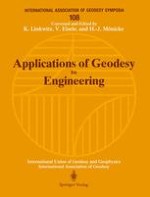Accuracy requirements of fractions of a millimeter for the positioning of beam-guiding magnets in synchrotons, monitor- ing of speedy sub-seatunnelling with lengths exceeding 25 km, the construction of extremely long bridges of suspension or "cast-and push"-type, but also geometrical industrial quality control and robot calibration in real time, and even the analysis of prestressed cable nets, are few examples of thechallenging new tasks demanding responses from the modern engineering-geodesist. In this volume, a general view of Engineering Geologyis presented, its state of the art and up-to-date information about recent scientific tasks, aims and methods. The contributions focus on Theoretical Aspects, Techniques of Measurements, Techniques of Data Processing and Computing, Reports About Selected Executed Projects, Special Tasks, e.g. Realtime Positioning and Navigation, Industrial Managements,Image Processing. But also the role of geo- desists in collaboration with civil and mechanical engineers, technical designers and architects is outlined. As a reference book, this volume will be useful for researchers, students and practitioners in Engineering Geodesy and neighbouring disciplines.
